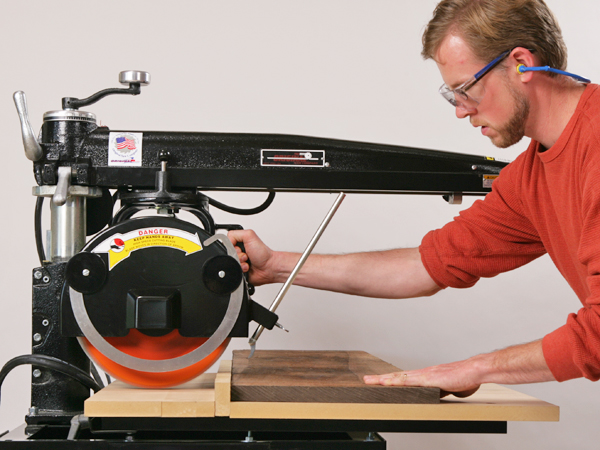
Are radial arm saws obsolete, especially when you take into account the latest compound miter saws out there on the market? And are they safe? (Shopsmith e-mail newsgroup)
Rob Johnstone: Radial arm saws are great and a very useful power tool. With the increasing popularity of power miter boxes and their slide-arm cousins, I can understand how the question could be asked, but my answer is they are in no way obsolete. The main reason they remain a great option for woodworkers is their versatility.
R.J. DeCristoforo used the radial arm saw for so many operations it would simply amaze you. He routed, sanded and did horizontal boring in addition to actually cutting wood with it. In fact he used it so often, I wonder if he could do woodworking at all without one. Paul Eckhoff of Ridgid Tools made the versatility point quite strongly when I posed the question to him. Ridgid introduced a brand new radial arm saw this year and I asked him point blank why they did it. Paul offered the opinion that radial arm saws offer a woodworker more options than a table saw. So if you think of radial arm saws as a power miter box on steroids, you might feel that their days have passed. But if you understand their remarkable versatility, you just might wonder what you are doing without one.
Rick White: I don’t know if they’re obsolete, but I know I wouldn’t buy one. The new compound miter saws and radial miter saws are much nicer. They are a lot more accurate and are becoming much more reasonably priced. The radial arm saw can be a lot more flexible if you add sanding accessories or chucks for shaping.
In terms of safety, they can be a bit more tricky. The blade is coming at you and is climbing the wood, so there’s a lot of momentum between the blade and arm toward the person using it. It can be pretty dangerous in the shop, but that can be said of any power tool. Just look at a chop saw and imagine the accidents that could cause. The danger of the radial arm saw is the way it walks toward you. I can also imagine safety issues when you’re ripping with one of these. If, for example, you’re ripping a long piece with a dado blade, I’d think the blade would ‘want’ to take that wood and throw it.
Ian Kirby: Radial arm saws were built for industry early last century when thick wide boards of solid wood were staple materials. They were used in mill work to rough cut to length, and in production, to cut to length. Holding a right angle was not a problem for the well engineered, heavily built machines, but the quality of the grain cut was poor since it was the age of the spacing set blade.
After WWII a lightweight downmarket version of a radial arm saw sold vigorously to homeowners?it was said to be the “must own” woodworking machine in the U.S. Unlike it’s industrial counterpart, it didn’t hold a right angle at all well and the quality of the end grain cut was what you got with the blade of the times. In the 60s, with the introduction of the TCT blade, the end grain cut was greatly improved but the inaccurate angle cut remained. Today’s mitre saws are better engineered than the “homeowner” radial arm saws. They are generally limited to a 12″ cut length and they use a TCT blade. They hold the set angle very well and deliver a first rate end grain cut?that for me takes care of to the vast majority of cross cuts. Dimensions longer than 12″ are best cut using a sliding cross cut fence or box on a table saw.
Are they safe? If they’re used to cross cut and if accuracy is not important, yes. If they are used in any other way, no.
Ellis Walentine: In my mind, radial arm saws are not at all obsolete. Although sliding compound miter saws do an excellent job of finish-crosscutting boards up to 12″ wide, nothing beats a radial arm saw for crosscutting wider stock and rough boards. Properly adjusted, the radial arm saw can cut very accurate dados, referenced on the opposite side of the board, which is a big advantage for some jobs.
The radial arm saw’s reputation has suffered because of the “do-everything” billing it received in the ’60s and 70s through the marketing efforts of a couple prominent mass marketers. It was touted as the best all-around solution not only for crosscutting, but also for ripping, dadoing, shaping, routing and saber-sawing. In fact, the radial saw is a poor match for many of these tasks; and some of these secondary operations, particularly ripping, have proven to be quite hazardous.





